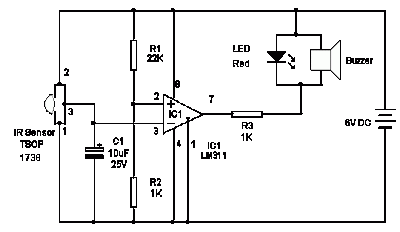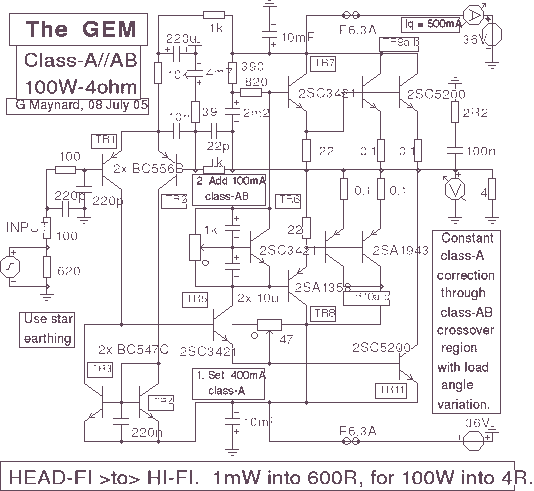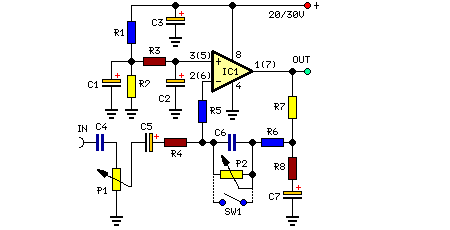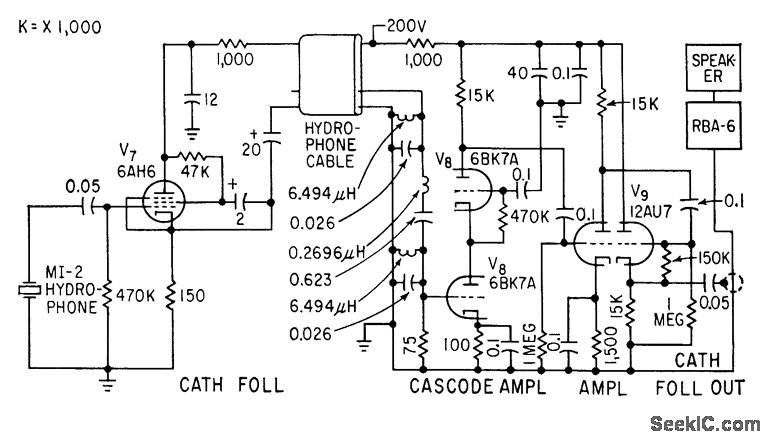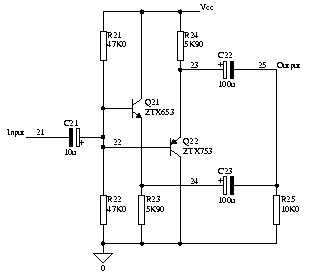
How to build Modular Class A Buffer preamplifier
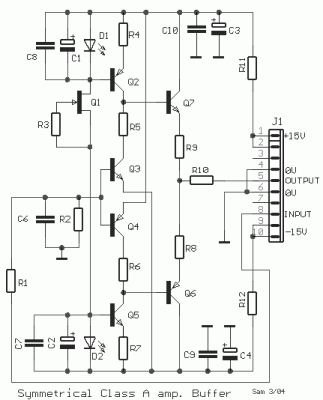
A unit that is often very useful for isolating two stages in sound circuits. This circuit features an amplification unit with a gain of X1, utilizing only local negative feedback instead of total negative feedback, resulting in very low distortion levels. Careful matching is required for the types of transistors and resistors used between them. Additionally, thermal coupling is necessary between the transistors, as well as with the LED diodes D1 and D2 in relation to transistors Q5 and Q2, respectively.
The described circuit functions as an isolation amplifier, suitable for applications where signal integrity is paramount, such as in audio processing. The use of local negative feedback allows for a controlled gain of X1, which helps maintain the fidelity of the audio signal while minimizing distortion. This characteristic is essential in high-fidelity audio applications where any introduction of noise or distortion can significantly degrade performance.
The careful selection and matching of transistors are critical to ensure optimal performance. Transistor parameters such as beta (current gain), Vbe (base-emitter voltage), and thermal characteristics must be closely aligned to ensure that the circuit operates effectively under varying conditions. Mismatched transistors can lead to imbalances that may introduce unwanted noise or distortion, thus it is recommended to use transistors from the same batch or series.
The inclusion of resistors between the transistors plays a vital role in setting the biasing conditions and stabilizing the operating point of the transistors. The values of these resistors should be calculated based on the desired operating current and voltage levels to ensure that the transistors operate within their linear region.
Thermal coupling is another important aspect of the design, as it ensures that the temperature variations in one transistor do not adversely affect the other. This is particularly critical in high-power applications where thermal runaway can occur. The thermal union between the transistors and the associated diodes (D1 and D2) allows for effective heat dissipation and ensures that the operating temperatures remain stable.
Diodes D1 and D2 serve as indicators or protection elements in the circuit, providing visual feedback on the operational status of the transistors Q5 and Q2. Proper orientation and connection of these diodes are essential to ensure that they function correctly within the circuit.
Overall, this circuit design emphasizes the importance of component selection, thermal management, and feedback mechanisms to achieve high performance and reliability in sound circuit applications.A unit which is often very useful, if we need to isolate, in sound circuits, two stage between them. Then we can use this circuit which has an amplified unit, which gain X1, we do not use total negative feedback, only local, with the result that distortion remains at a very low level. Matching must be done with great care to the types of transisto rs, resistor between them. There must also be thermal union between the transistors, as well as the diodes LED D1-2 with the transistor Q5 and Q2 respectively. 🔗 External reference
The described circuit functions as an isolation amplifier, suitable for applications where signal integrity is paramount, such as in audio processing. The use of local negative feedback allows for a controlled gain of X1, which helps maintain the fidelity of the audio signal while minimizing distortion. This characteristic is essential in high-fidelity audio applications where any introduction of noise or distortion can significantly degrade performance.
The careful selection and matching of transistors are critical to ensure optimal performance. Transistor parameters such as beta (current gain), Vbe (base-emitter voltage), and thermal characteristics must be closely aligned to ensure that the circuit operates effectively under varying conditions. Mismatched transistors can lead to imbalances that may introduce unwanted noise or distortion, thus it is recommended to use transistors from the same batch or series.
The inclusion of resistors between the transistors plays a vital role in setting the biasing conditions and stabilizing the operating point of the transistors. The values of these resistors should be calculated based on the desired operating current and voltage levels to ensure that the transistors operate within their linear region.
Thermal coupling is another important aspect of the design, as it ensures that the temperature variations in one transistor do not adversely affect the other. This is particularly critical in high-power applications where thermal runaway can occur. The thermal union between the transistors and the associated diodes (D1 and D2) allows for effective heat dissipation and ensures that the operating temperatures remain stable.
Diodes D1 and D2 serve as indicators or protection elements in the circuit, providing visual feedback on the operational status of the transistors Q5 and Q2. Proper orientation and connection of these diodes are essential to ensure that they function correctly within the circuit.
Overall, this circuit design emphasizes the importance of component selection, thermal management, and feedback mechanisms to achieve high performance and reliability in sound circuit applications.A unit which is often very useful, if we need to isolate, in sound circuits, two stage between them. Then we can use this circuit which has an amplified unit, which gain X1, we do not use total negative feedback, only local, with the result that distortion remains at a very low level. Matching must be done with great care to the types of transisto rs, resistor between them. There must also be thermal union between the transistors, as well as the diodes LED D1-2 with the transistor Q5 and Q2 respectively. 🔗 External reference
